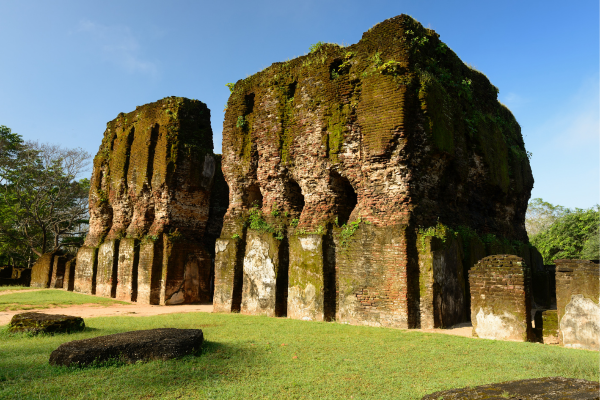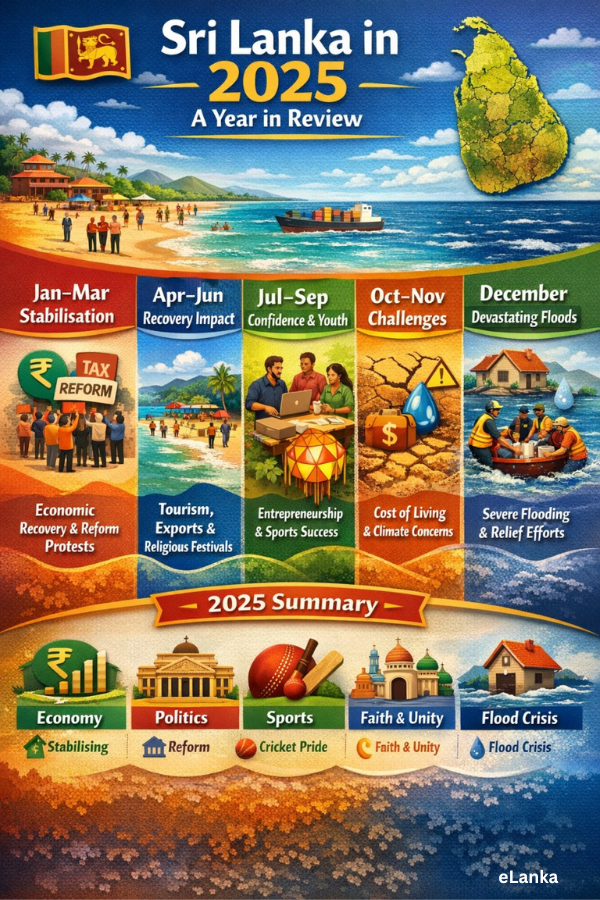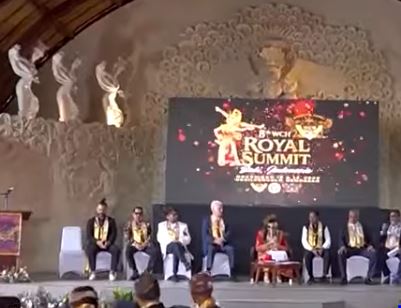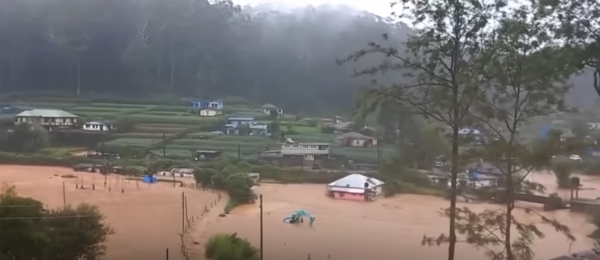Royal Palace Polonnaruwa – architectural marvel of yesteryear – By Arundathie Abeysinghe
Source : wikipedia
 Considered as the ruins of the Royal Palace Polonnaruwa, this majestic palace constructed under the guidance of King Parakramabahu I (1153-1186) during his reign is an architectural marvel of yesteryear. This has been a seven-story palace comprising 1000 chambers.
Considered as the ruins of the Royal Palace Polonnaruwa, this majestic palace constructed under the guidance of King Parakramabahu I (1153-1186) during his reign is an architectural marvel of yesteryear. This has been a seven-story palace comprising 1000 chambers.
Located in *Polonnaruwa, the Palace was known as “Vijayotpaya” or “Vijayanta Prasada” (meaning the Palace of *God Sakra). As there had been seven stories, the building has also been called “Sathbumupaya” (in Sinhala). The remaining huge walls are over one meter thick and rise to approximately nine meters (30 feet). A section of the stairs and the foundation walls are indications of the size of the building.
According to archaeological records, the Royal Palace would have been one of the tallest occupied buildings in the world during that time and its foundation is still impressive, approximately 1,000 years, later.
Archaeologists are of the view that the bottom half of the main stairway would have led to upper floors. Inside the building, there are sections of melted brick walls caused by intense heat when the building had been set fire by invaders at the end of the Polonnaruwa era. (The Palace may have been destroyed by fire during enemy invasions).
Around the main palace, there are ruins of several buildings. According to chronicles, this unique palace, constructed in 12th century AD had been shared with ministers, generals and officers who served the Kingdom.
Scholars are of the view that the large cavities in the wall dotted with an equidistance around would have held enormous wooden structures that formed the floor of the upper levels and have been utilized for wooden beams that would have delineated different floors. Despite destruction caused due to enemy invasions and being subject to adverse weather conditions for approximately 800 years, the plastering on the walls remains intact, in certain places. In addition to the main building, there are also ruins of some small buildings around it.
The Kingdom had been subjected to constant *Chola invasions during the 14th century and resulted in the magnificent palace to be plundered and razed to the ground. Thereafter, the Palace was not reconstructed. Although, the Palace does not display its original grandeur, it is a testament to the architectural craftsmanship of the ancient kingdom, display of a thriving kingdom rich in culture, art, and engineering ingenuity as well as the marvelous skills of our ancestors.
Scholars are of the view that the unique palace would have been a complex of buildings. Towards the south of the main palace, the remains of the audience hall and the bathing pools of the Palace are situated.
Foreign visitors are of the view that the height of the Royal Palace building is similar to 7-story Equitable Life Building in New York, constructed in 1870.
Architects and engineers are of the view that the basic floor plan of the Palace is similar to the 12th century Vijayabahu Palace at Anuradhapura and palaces at *Yapahuwa and *Panduwasnuwara.
At present too, there are ruins of three stories of bricks.
*Mahawamsa describes in detail about the Palace; it had a square shape and the diagonal of the Palace intersect in the middle of the palace and the diagonal from the outer wall intersect in front of the front door of the palace. The area outside the palace has been reserved for the senior members of the Palace including the King’s ministers.
There is one main hall in the Palace surrounded by 40 interconnecting rooms. The Palace as well as its courtyard are protected by huge walls (over one meter thick and rising up to nine meters, approximately 30 feet) encircled with another outer wall. The bottom portion of the main stairway led to upper floors. Archaeologists are of the view that some method similar to an elevator would have been utilized in the past to reach the upper floors as this location was the King’s living area. Hence, it is unlikely that the King had climbed the steps to go to upper floors.
There is an architect’s impression of the original structure of the Royal Palace displayed at the Polonnaruwa Archaeological Museum (as a miniature model). Many tourists visit the Museum as there are artefacts and a detailed description of the ancient city of Polonnaruwa which also includes a scale model of the Polonnaruwa Council Chamber.
Royal Palace Polonnaruwa is listed as a UNESCO World Heritage Site.
Image courtesy –Wikimedia Commons
- Anuradhapura Period – This was a period in the history of Sri Lanka from 377 BC -1017 AD when the Anuradhapura Kingdom was established as the first kingdom in ancient Sri Lanka. King Pandukabhaya (474 BC – 367 BC) was the first monarch to rule Sri Lanka from Anuradhapura from 377 BC. Buddhism played a major role during the Anuradhapura Period.
- Chola conquest – This was a military invasion of the Anuradhapura Kingdom by the Chola Empire of Southern India, one of the longest ruling dynasties in world history. Initially, the Anuradhapura Kingdom was invaded in 993 AD and absorbed it into the Chola Empire of Southern India.
- God Sakra – “Sakra” (Sanskrit) meaning powerful also known as “Sakka” (Pali) is a powerful god referred in Buddhism, Hinduism as well as in Jainism. In Buddhism, Sakra is referred as the ruler of the Trayastrimsa Heaven (world of the devas – gods in Buddhist cosmology). In legendary anecdotes, Sakra mentioned in Buddhist texts is different from the Hindu Indra. Sakra is frequently depicted in Buddhist Literature as a being who consults the Buddha regarding issues of morality.
- Mahawamsa – “Great Chronicle” or “Great Dynasty” in Sinhala is the most significant work of Sri Lankan origin written in Pali Language. This Chronicle describes life and times of Sri Lankans from the arrival of Vijaya in 43 BC to the reign of King Mahasena from sixth century BC to fourth century AD. Culavamsa (lesser chronicle) covers the period from fourth century AD to British takeover of Sri Lanka, in 1815. Mahawamsa consists of three parts covering a historical record of over two millennia. It is considered as the world’s longest unbroken historical record.
- Panduwasnuwara – An ancient capital situated in Kurunegala District, considered as the controlling center known as “Parakramapura” of Dakkhinadesa in the 12th century. Panduwasnuwara was ruled by Parakramabahu I also known as “Parakramabahu the Great”, the ruler of Polonnaruwa Kingdom (1153-1186) who set up his temporary capital in Panduwasnuwara in the 12th century. He masterminded the expansion and beautification of his capital by constructing extensive irrigation systems, reformed Buddhist practices, encouraged the arts, reorganized the country’s army and undertook military campaigns in South India and Burma.
- Polonnaruwa – The Kingdom of Polonnaruwa or the ancient city of Polonnaruwa (also known as “Pulastipura”) was the second capital of Sri Lanka for three centuries from 11th to 13th centuries. After the *Chola conquest of *Anuradhapura Kingdom, the center of administration was shifted to Polonnaruwa until 1232. Polonnaruwa has been declared a World Heritage Site by UNESCO.
Yapahuwa Rock Fortress – ephemeral capital of Sri Lanka –By Arundathie Abeysinghe – Nov 22, 2020






















